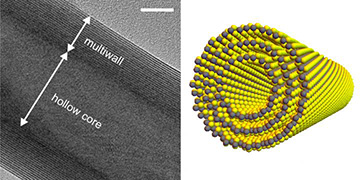
Left: Transmission electron microscopy image of a hollow core nanotube. The white scale bar corresponds to 10 nm. Right: Artist’s rendering of a nanotube. [Image: © 2019 Iwasa et al]
An international team of scientists has found that nanotubes made of a junction-less semiconductor compound generate current when exposed to light (Nature, doi:10.1038/s41586-019-1303-3). The phenomenon depends on the structure of the nanotube material, not on the presence of p-n junctions, and could lead to new insights into the photovoltaic behavior of these shaped materials.
Exploring structured materials
The nanotubes investigated at the University of Tokyo, Japan, and other institutions consist of tungsten disulfide, one of the compounds known as transition-metal dichalcogenides or TMDs. Scientists have been studying members of the TMD family for interesting quantum effects based on their structures.
Since photovoltaic cells based on p-n junction semiconductors are approaching the theoretical efficiency limits, researchers are seeking to find other ways to harvest electricity from sunlight. The bulk photovoltaic effect—sometimes known as the anomalous photovoltaic effect—occurs when the open-circuit voltage generated by light exceeds the band gap of the material, though the effect has not yet led to any practical devices.
Tokyo physicist Yoshihiro Iwasa and his colleagues, including Yijin Zhang of the Max Planck Institute for Solid State Research, Germany, shone laser light onto these tungsten disulfide nanotubes and onto monolayers of the same material. From that light, the nanotubes generated “orders of magnitude” more current density than other materials exhibiting the bulk photovoltaic effect, according to the researchers. To their knowledge, this is the first observation of the effect in a structured, rather than bulk, material.
The researchers tried three different laser wavelengths and found that the strongest response was at 632.8 nm, a wavelength close to an exciton resonance of the material.
Trust but verify
Zhang says that the greatest challenge in the study was to verify that the bulk photovoltaic effect was indeed an intrinsic property of the nanotubes, based on the underlying quantum mechanics of the arranged atoms. “As you know, there are many ways to generate current in general even without p-n junctions,” he says. It is relatively easy for scientists to separate the contributions from each mechanism in bulk materials, but much more difficult in nanomaterials.
The straightforward way to verify the existence of the bulk photovoltaic effect is to observe spontaneous electrical polarization in the material. “However, the nanotubes are not ferroelectric: their polarization is fixed by the chirality of the tube and we cannot alter it,” Zhang says. Thus, team members needed to perform multiple control experiments to exclude other explanations for the results before attributing them to the bulk photovoltaic effect.
As an experimental physicist, Zhang says he's most interested in clarifying the origin of the effect and using the insight to develop materials with higher conversion efficiency. Scientists in other fields might be interested in improving the methods for synthesizing dichalcogenide nanotubes, with an eye toward controlling and standardizing the chirality of the tiny tubes. Device engineers could look for a way to make a film out of identically chiral, well-aligned nanotubes that could form the basis for future generations of solar panels.
Also contributing to the study were researchers from Osaka University and the RIKEN Center for Emergent Matter Science, both in Japan, and the Holon Institute for Technology and Weizmann Institute for Science, both in Israel.
